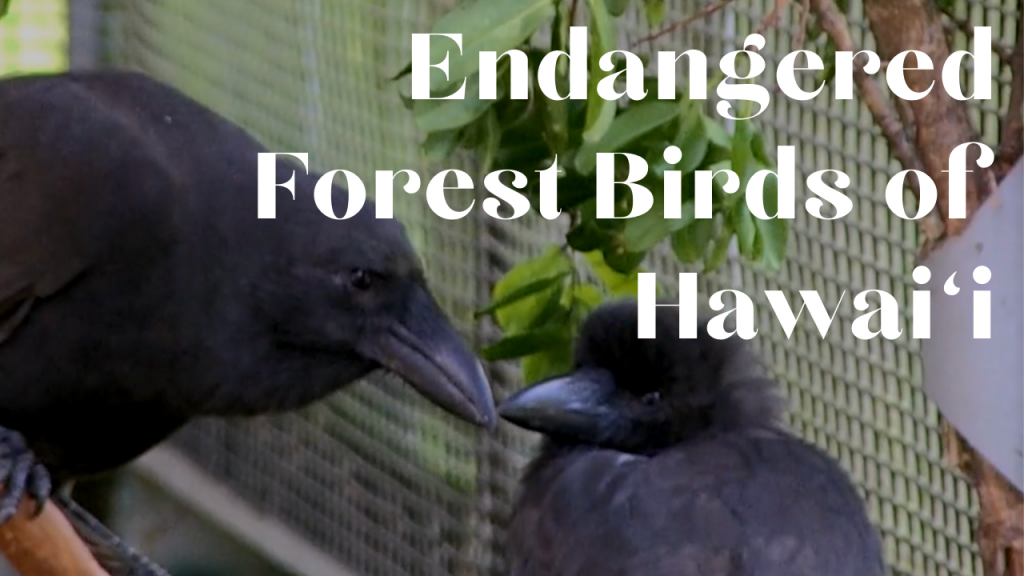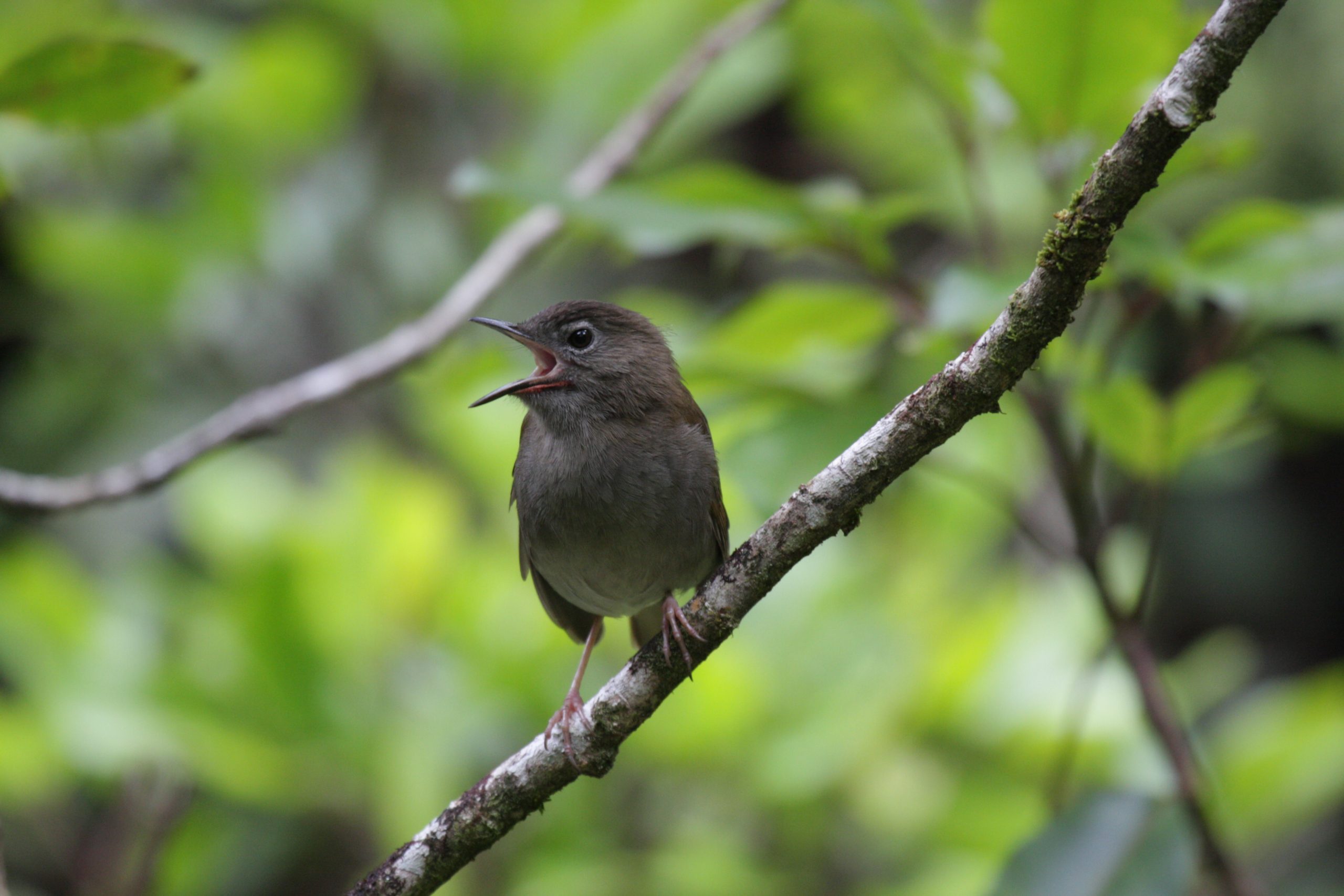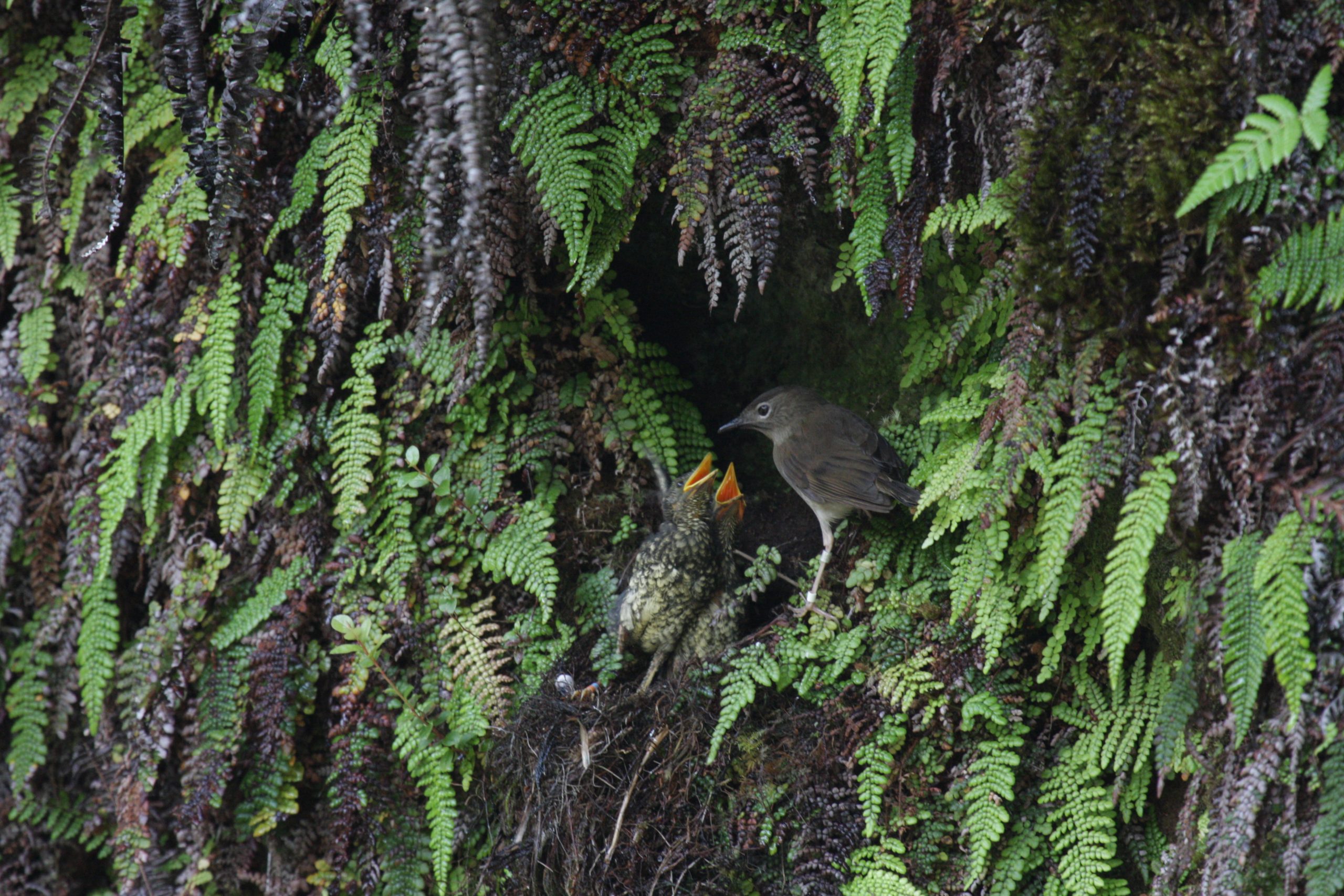Puaiohi

Names
- ʻŌlelo Hawaiʻi: Puaiohi
- Common: Small Kaua‘i Thrush
- Scientific: Myadestes palmeri
Song
Conservation Status
- Federally Listed as Endangered
- State Listed as Endangered
- State Recognized as Endemic
- NatureServe Heritage Rank G1—Critically Imperiled
- IUCN Red List Ranking—Critically Endangered
- Revised Recovery Plan for Hawaiian Forest Birds—USFWS 2006
Species Information
The puaiohi, or small Kaua‘i thrush, is the smaller of two solitaires (family: Turdidae) endemic to Kaua‘i, and was the last of the island’s avifauna to be discovered by western ornithologists. In the late 1800s, the puaiohi was considered exceedingly rare, but this assessment was likely due to their behavior pattern to conceal itself and preference for remote, inaccessible ravines. Adult puaiohi are extremely sedentary and appear to have specific habitat requirements. Of the five Hawaiian solitaires, it is behaviorally, morphologically, and vocally the most different. Compared to the kāma‘o, or large Kaua‘i thrush (M. myadestinus), the puaiohi has a short tail, and a white eye-ring. In addition, it has a relatively simple song. The species life history is relatively well-known because of recent, intensive studies. Fruit dominates the non-breeding season diet; insects are important during the breeding season. Nests are built by the female in cavities or on cliff ledges, and only females incubate eggs and brood young. Breeding peaks from April to June, and re-nesting occurs after failed and successful nest attempts. This behavior, plus a high rate of nest success and a long breeding season, can result in high annual productivity. However, female and juvenile survival is low. Hatch-year and second-year birds (i.e., helpers) are known to assist in nest defense and feeding of related nestlings and fledglings at some sites. Young are very sedentary for two to four days after fledging.
Distribution
Restricted to a < 20 square kilometer (7.6 square mile) area on the southern and central plateau of the Alaka‘i Wilderness Preserve. Currently occurs above 1,050 meters (3,450 feet), which is similar to its upper limit historically. It is more likely to occur in streams between 1,140 and 1,340 meters with large numbers of tall, steep cliffs than in less incised streams.
Habitat
Puaiohi seem somewhat tolerant of avian malaria, so it is not clear what is restricting them to higher elevations—perhaps loss and degradation of habitat (see below). Occurs in deeply dissected, steep-walled ravines supporting wet montane forest dominated by ‘ōhi‘a (Metrosideros polymorpha) and ‘ōlapa (Cheirodendron spp.). Their former range included mesic areas dominated by ‘ōhi‘a and koa (Acacia koa). These areas are now largely dominated by introduced plant species including fire tree (Myrica faya) and strawberry guava (Psidium cattleianum). Densities are very low even in apparently suitable habitat. The entire known range of this species is within the Alaka‘i Wilderness Preserve and Nā Pali Kona Forest Reserve, which are and is managed by the State of Hawai‘i. However, models predict that low numbers of puaiohi occur on private lands adjacent to these areas.
Threats
- Disease. In 1995-1997, seven puaiohi were tested for disease; none carried malarial (Plasmodium relictum) antibodies. Since 2007, 15/66 puaiohi have tested positive for malarial antibodies. Survival of puaiohi that tested positive was similar to that of puaiohi that tested negative, indicating a possible resistance to or tolerance of malaria.
- Predation. Two years of field data indicate that rats (Rattus spp.) were responsible for 14 to 22 percent of nest failures, as well as mortality of three adult females. Subsequent studies documented at least three other instances of predation on adults at the nest, and the lower survival of females (0.46 + 0.12) compared to males (0.71 + 0.09) is indicative of predation on females at the nest. Fledglings typically spend their first days out of the nest within 2 meters (6.5 feet) of the ground, which makes them vulnerable to feral cats.
- Competition. Several non-native birds, including the introduced Japanese white-eyes (Zosterops japonicus), melodious laughing thrush (Copsychus malabaricus), and whiterumped shama (Copsychus malabaricus), occupy the same habitat and may compete with the puaiohi for food and nest resources. Shama have been observed nesting in nest boxes erected to promote Puaiohi nesting on at least two occasions. Preliminary dissection of fecal samples indicate that Japanese white-eyes eat primarily non-native fruits, whereas puaiohi eat native fruits almost exclusively. Fecal samples of shama and laughing thrush have not been obtained.
- Habitat degradation. Feral pigs (Sus scrofa) and goats (Capra hircus) have facilitated the invasion of non-native plants into puaiohi habitat. The establishment of these plants has altered the structure of these forests, especially the ground and shrub layer, and especially in the western part of the puaiohi’s range where it is now exceedingly rare. Hurricanes in 1982 and 1992 further altered and degraded the forests of Kaua‘i, including those within the Alaka‘i Wilderness Preserve.
- Non-native arthropods. Recently introduced non-native insects, especially yellow jackets (Vespula pensylvanica) and Argentine ants (Linepithema humile), may compete with the puaiohi’s native arthropod prey or disrupt the pollination of the species’ food plants. Introduced herbivorous insects also could reduce the abundance of food plants.
- Natural disasters. Hurricanes in 1982 and 1992 likely caused the death of an unknown number of individuals.
Explore From Home
Plans & Projects
Additional Resources
For more information and references visit the DLNR State Wildlife Action Plan factsheets. DOFAWʻs species pages and State Wildlife Action Plan fact sheets are provided for general information and are not meant to be a citable, original source of data. If you are a student, researcher, or writer looking for a citable source, please explore the references below or find other original data sources, rather than citing these webpages. The references below were provided by the authors of the State Wildlife Action Plan fact sheets at the time of drafting:
- Atkinson, CT, RB Utzurrum, DA LaPointe, RJ Camp, LH Crampton, JT Foster, and TW Giambelluca. 2014. Changing Climate and the Altitudinal Range of Avian Malaria in the Hawaiian Islands – an Ongoing Conservation Crisis on the Island of Kaua‘i. Global Change Biology 20, 2426–2436, doi: 10.1111/gcb.12535.
- Foster JT, Tweed EJ, Camp RJ, Woodworth BL, Adler CD, Telfer T. 2004. Long-term population changes of native and introduced birds in the Alaka’i swamp, Kaua’i. Conservation Biology 18:716-725.
- IUCN Red List of Threatened Species. 2015. Version 2014.3. Available at: www.iucnredlist.org. (Accessed May 2015).
- Scott JM, Mountainspring S, Ramsey FL, Kepler CB. 1986. Forest bird communities of the Hawaiian islands: their dynamics, ecology and conservation. Lawrence, (KS): Cooper Ornithological Society.
- Switzer R., Lieberman A, Nelson J, Crampton LH. 2013. Augmentation of the Puaiohi population through captive propagation and release on the Alakai Plateau, Kauai, Hawaii, USA. Reintroduction Specialist Group Book, IUCN.
- U.S. Fish and Wildlife Service. 2006. Revised Recovery plan for Hawaiian forest birds. Portland, (OR): U.S. Fish and Wildlife Service..
- Vanderwerf, EA, LH Crampton, PK Roberts, JS Diegmann, and DL Leonard. 2014. Survival estimates of wild and captive-released Puaiohi, an endangered Hawaiian thrush. Condor 116: 609–618. DOI: 10.1650/CONDOR-14-18.1
- Wakelee KM, Fancy SG. 1999. ‘Oma’o (Myadestes obscurus), kama’o (Myadestes myadestinus), oloma’o (Myadestes lanaiensis), and ‘amaui (Myadestes woahensis). In The Birds of North America, No. 460 (Poole A, Gill F, editors.). Philadelphia, (PA): The Academy of Natural Sciences; and Washington DC: The American Ornithologists’ Union.

 The Endangered Forest Birds of Hawaiʻi
The Endangered Forest Birds of Hawaiʻi
